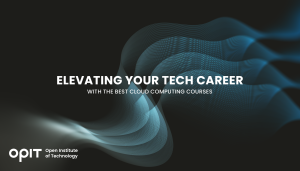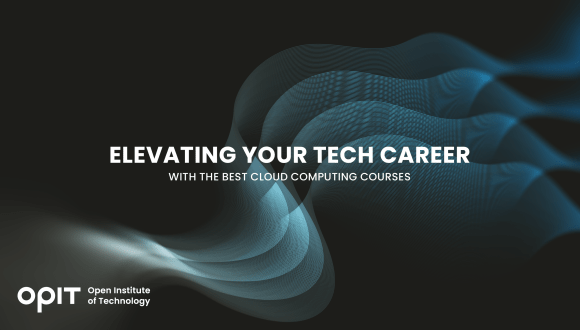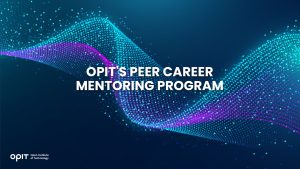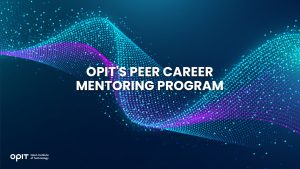

There was a time when cloud computing was nothing more than an interesting concept, but today the cloud computing industry is worth in the region of $371 billion. Businesses are leveraging the power and scalability of cloud computing due to its flexibility, enhanced security and cost savings realized through the reduction of expensive IT infrastructure maintenance.
Those professionals who are intent on becoming leaders in the ever-evolving world of cloud computing need appropriate skills and a world-class qualification, and that means finding the best cloud computing courses.
Understanding Cloud Computing and Its Courses
Cloud computing focuses on the delivery of computing services over the internet. These services can include database management, server hosting, storage, networking, online software solutions, and analytics. A recognized qualification in cloud computing will incorporate course content covering these areas and is essential for cloud innovators and future leaders.
Discovering the Best Cloud Computing Courses
A career in cloud computing provides a wealth of choice. There are qualifications that will prepare the student for a career as a Cloud Architect, Cloud Engineer, developer, or consultant. There are also more specialized careers involving cloud security or operations management. The key to a successful career in any of these fields is selecting the best cloud computing courses and qualifications.
Qualifications that will put the aspirant cloud expert on the fast track to success will be offered by recognized and certified educational institutions. Coursework should ideally cover both theoretical foundations and the practical application of skills.
Some criteria to consider when choosing the best cloud computing courses:
- Comprehensive Curriculum. Ensure that the coursework of their chosen qualification covers the skills required for career advancement. Ideally, it should include foundational cloud concepts, infrastructure management, security, practical implementation, and vendor-specific training, depending on the desired career path.
- Appropriate Teaching Methodology. Identify education providers that offer platforms including a mix of learning formats. Prioritize coursework that includes virtual instructor-led lectures, hands-on experience, real-world projects, and cloud sandboxes to allow for knowledge and application testing.
- Flexible Offerings. Many potential students will already have careers. Even those who do not hold full-time positions may be time-poor. The best cloud computing courses will make allowances for this by offering accessible and flexible options for study.
- Reputation and Accreditation. Prioritize offerings from reputable educational institutions that are acknowledged by industry leaders. The providers should be accredited by recognized regulatory bodies, offering industry leaders and organizations peace of mind when evaluating a potential employee.
Here are the top five cloud computing courses available on- and off-line to help get you started:
1. OPIT BSc in Modern Computer Science
The fully accredited OPIT BSc in Modern Computer Science provides students with the flexibility of online and fully remote coursework and study. The degree was developed to provide students with comprehensive foundation skills, both theoretical and practical. Courses include programming, software development, database management, cloud computing, cybersecurity, data science and artificial intelligence.
2. Introduction to Amazon Web Services Cloud Computing
Amazon Web Services (AWS) is the world’s leading cloud computing platform. This beginner-friendly “Introduction to Cloud Computing on AWS” qualification will provide hands-on, practical skills related to both fundamental cloud computing concepts and advanced AWS competencies.
The coursework consists of seven hours of easily accessible video and two articles. Content can be accessed online, and the successful student will receive a certificate of completion. The skills obtained during the study are perfect for those who want to progress to either a qualification as an AWS Certified Cloud Practitioner or an AWS Certified Solutions Architect.
3. Udemy – Getting Started With Cloud Computing – Level 1
This Udemy program provides a grounding in some fundamental cloud computing concepts. It includes course content such as cloud fundamentals and the five basic concepts that underpin cloud computing. The coursework also covers an introduction to service models such as SaaS, PaaS, and IaaS, and deployment models (private, public, hybrid, and community).
4. Coursera Cloud Computing Concepts (Part 1)
This flexible 23-hour course will provide foundational skills in distributed algorithms, distributed and cloud computing, and C++. Students will have access to industry experts to get a practical understanding of cloud computing and related subjects. Coursework includes hands-on projects that are relevant to individual career paths. A shareable ‘career certificate’ ideal for LinkedIn use is available to those obtaining the qualification.
5. Udemy Ultimate AWS Certified Solutions Architect Associate SAA-C03
This course is among the best cloud computing courses available. It is ideal for aspirant professionals who want to take their AWS qualifications to the next level. The coursework is flexible and allows students access to 800+ explanatory slides and a practice exam (with answer explanations). Students will have the opportunity to learn solution architecture analysis and database management, AWS fundamentals, and the implementation of real-world architecture using AWS.
The Skills You Gain From Top Cloud Computing Courses
Qualifications offered by accredited education institutions will provide both foundational and advanced competencies in cloud-related subjects. Students will obtain theoretical and practical knowledge that will advance their careers in the ever-evolving world of cloud computing.
A diverse skillset, including subjects such as database management, coding, and understanding the complexities of the various cloud solutions available is essential for those who are committed to a career in the cloud. However, these skills are not only applicable to the domain of cloud computing. Many are highly sought-after skills that are perfect for various IT and digital business roles, giving degree-holders options about their career trajectories.
Choosing the Right Course for Your Career Goals
The explosion of cloud applications and functionality provides enormous scope for a variety of career paths. These can include careers in cloud architecture, cloud application development, systems administration, front-end development, business consulting, cloud security, and data science, among many others.
The key to a successful cloud-based career is to understand the various career paths available and to ensure that the chosen path helps meet career objectives. An essential part of this journey is focusing on the best cloud computing courses.
How OPIT’s Cloud Computing Course in the BSc in Modern Computer Science Stands Out
The OPIT BSc in Modern Computer Science has become the preferred choice of those who want to fast-track their career in cloud computing. The coursework for the program provides the student with foundational, advanced, and real-world skills and leverages state-of-the-art tools and input from industry leaders and academic experts to provide actionable learning.
Flexibility and remote learning make this qualification the ideal choice for those who simply cannot commit to full-time study.
OPIT (Open Institute of Technology) is a fully licensed and accredited online higher education, a factor that can influence hiring decisions. It is recognized by the MFHEA under the European Qualification Framework (EQF) and the Malta Qualification Framework (MQF).
A Cloud Computing Qualification – Your Key to Success
The cloud is today part and parcel of the modern business environment, and it continues to evolve. This continued evolution provides incredible opportunities for the business leaders of tomorrow.
Carefully researching the best cloud computing courses is the key to success in the growing industry. However, the prospective student needs to take extra care when selecting their desired qualification and area of study. The coursework should complement the student’s chosen career path and offer the flexibility to study when and where they want.
OPIT is recognized as a premium education provider. The recognition of OPIT accreditation from leading standards authorities lends further weight to any qualification received from this respected institution. A qualification from OPIT opens the door to a stimulating and rewarding career at the cutting edge of cloud development.
Related posts

Source:
- Raconteur, published on November 06th, 2025
Many firms have conducted successful Artificial Intelligence (AI) pilot projects, but scaling them across departments and workflows remains a challenge. Inference costs, data silos, talent gaps and poor alignment with business strategy are just some of the issues that leave organisations trapped in pilot purgatory. This inability to scale successful experiments means AI’s potential for improving enterprise efficiency, decision-making and innovation isn’t fully realised. So what’s the solution?
Although it’s not a magic bullet, an AI operating model is really the foundation for scaling pilot projects up to enterprise-wide deployments. Essentially it’s a structured framework that defines how the organisation develops, deploys and governs AI. By bringing together infrastructure, data, people, and governance in a flexible and secure way, it ensures that AI delivers value at scale while remaining ethical and compliant.
“A successful AI proof-of-concept is like building a single race car that can go fast,” says Professor Yu Xiong, chair of business analytics at the UK-based Surrey Business School. “An efficient AI technology operations model, however, is the entire system – the processes, tools, and team structures – for continuously manufacturing, maintaining, and safely operating an entire fleet of cars.”
But while the importance of this framework is clear, how should enterprises establish and embed it?
“It begins with a clear strategy that defines objectives, desired outcomes, and measurable success criteria, such as model performance, bias detection, and regulatory compliance metrics,” says Professor Azadeh Haratiannezhadi, co-founder of generative AI company Taktify and professor of generative AI in cybersecurity at OPIT – the Open Institute of Technology.
Platforms, tools and MLOps pipelines that enable models to be deployed, monitored and scaled in a safe and efficient way are also essential in practical terms.
“Tools and infrastructure must also be selected with transparency, cost, and governance in mind,” says Efrain Ruh, continental chief technology officer for Europe at Digitate. “Crucially, organisations need to continuously monitor the evolving AI landscape and adapt their models to new capabilities and market offerings.”
An open approach
The most effective AI operating models are also founded on openness, interoperability and modularity. Open source platforms and tools provide greater control over data, deployment environments and costs, for example. These characteristics can help enterprises to avoid vendor lock-in, successfully align AI to business culture and values, and embed it safely into cross-department workflows.
“Modularity and platformisation…avoids building isolated ‘silos’ for each project,” explains professor Xiong. “Instead, it provides a shared, reusable ‘AI platform’ that integrates toolchains for data preparation, model training, deployment, monitoring, and retraining. This drastically improves efficiency and reduces the cost of redundant work.”
A strong data strategy is equally vital for ensuring high-quality performance and reducing bias. Ideally, the AI operating model should be cloud and LLM agnostic too.
“This allows organisations to coordinate and orchestrate AI agents from various sources, whether that’s internal or 3rd party,” says Babak Hodjat, global chief technology officer of AI at Cognizant. “The interoperability also means businesses can adopt an agile iterative process for AI projects that is guided by measuring efficiency, productivity, and quality gains, while guaranteeing trust and safety are built into all elements of design and implementation.”
A robust AI operating model should feature clear objectives for compliance, security and data privacy, as well as accountability structures. Richard Corbridge, chief information officer of Segro, advises organisations to: “Start small with well-scoped pilots that solve real pain points, then bake in repeatable patterns, data contracts, test harnesses, explainability checks and rollback plans, so learning can be scaled without multiplying risk. If you don’t codify how models are approved, deployed, monitored and retired, you won’t get past pilot purgatory.”
Of course, technology alone can’t drive successful AI adoption at scale: the right skills and culture are also essential for embedding AI across the enterprise.
“Multidisciplinary teams that combine technical expertise in AI, security, and governance with deep business knowledge create a foundation for sustainable adoption,” says Professor Haratiannezhadi. “Ongoing training ensures staff acquire advanced AI skills while understanding associated risks and responsibilities.”
Ultimately, an AI operating model is the playbook that enables an enterprise to use AI responsibly and effectively at scale. By drawing together governance, technological infrastructure, cultural change and open collaboration, it supports the shift from isolated experiments to the kind of sustainable AI capability that can drive competitive advantage.
In other words, it’s the foundation for turning ambition into reality, and finally escaping pilot purgatory for good.

The Open Institute of Technology (OPIT) is the perfect place for those looking to master the core skills and gain the fundamental knowledge they need to enter the exciting and dynamic environment of the tech industry. While OPIT’s various degrees and courses unlock the doors to numerous careers, students may not know exactly which line of work they wish to enter, or how, exactly, to take the next steps.
That’s why, as well as providing exceptional online education in fields like Responsible AI, Computer Science, and Digital Business, OPIT also offers an array of career-related services, like the Peer Career Mentoring Program. Designed to provide the expert advice and support students need, this program helps students and alumni gain inspiration and insight to map out their future careers.
Introducing the OPIT Peer Career Mentoring Program
As the name implies, OPIT’s Peer Career Mentoring Program is about connecting students and alumni with experienced peers to provide insights, guidance, and mentorship and support their next steps on both a personal and professional level.
It provides a highly supportive and empowering space in which current and former learners can receive career-related advice and guidance, harnessing the rich and varied experiences of the OPIT community to accelerate growth and development.
Meet the Mentors
Plenty of experienced, expert mentors have already signed up to play their part in the Peer Career Mentoring Program at OPIT. They include managers, analysts, researchers, and more, all ready and eager to share the benefits of their experience and their unique perspectives on the tech industry, careers in tech, and the educational experience at OPIT.
Examples include:
- Marco Lorenzi: Having graduated from the MSc in Applied Data Science and AI program at OPIT, Marco has since progressed to a role as a Prompt Engineer at RWS Group and is passionate about supporting younger learners as they take their first steps into the workforce or seek career evolution.
- Antonio Amendolagine: Antonio graduated from the OPIT MSc in Applied Data Science and AI and currently works as a Product Marketing and CRM Manager with MER MEC SpA, focusing on international B2B businesses. Like other mentors in the program, he enjoys helping students feel more confident about achieving their future aims.
- Asya Mantovani: Asya took the MSc in Responsible AI program at OPIT before taking the next steps in her career as a Software Engineer with Accenture, one of the largest IT companies in the world, and a trusted partner of the institute. With a firm belief in knowledge-sharing and mutual support, she’s eager to help students progress and succeed.
The Value of the Peer Mentoring Program
The OPIT Peer Career Mentoring Program is an invaluable source of support, inspiration, motivation, and guidance for the many students and graduates of OPIT who feel the need for a helping hand or guiding light to help them find the way or make the right decisions moving forward. It’s a program built around the sharing of wisdom, skills, and insights, designed to empower all who take part.
Every student is different. Some have very clear, fixed, and firm objectives in mind for their futures. Others may have a slightly more vague outline of where they want to go and what they want to do. Others live more in the moment, focusing purely on the here and now, but not thinking too far ahead. All of these different types of people may need guidance and support from time to time, and peer mentoring provides that.
This program is also just one of many ways in which OPIT bridges the gaps between learners around the world, creating a whole community of students and educators, linked together by their shared passions for technology and development. So, even though you may study remotely at OPIT, you never need to feel alone or isolated from your peers.
Additional Career Services Offered by OPIT
The Peer Career Mentoring Program is just one part of the larger array of career services that students enjoy at the Open Institute of Technology.
- Career Coaching and Support: Students can schedule one-to-one sessions with the institute’s experts to receive insightful feedback, flexibly customized to their exact needs and situation. They can request resume audits, hone their interview skills, and develop action plans for the future, all with the help of experienced, expert coaches.
- Resource Hub: Maybe you need help differentiating between various career paths, or seeing where your degree might take you. Or you need a bit of assistance in handling the challenges of the job-hunting process. Either way, the OPIT Resource Hub contains the in-depth guides you need to get ahead and gain practical skills to confidently move forward.
- Career Events: Regularly, OPIT hosts online career event sessions with industry experts and leaders as guest speakers about the topics that most interest today’s tech students and graduates. You can join workshops to sharpen your skills and become a better prospect in the job market, or just listen to the lessons and insights of the pros.
- Internship Opportunities: There are few better ways to begin your professional journey than an internship at a top-tier company. OPIT unlocks the doors to numerous internship roles with trusted institute partners, as well as additional professional and project opportunities where you can get hands-on work experience at a high level.
In addition to the above, OPIT also teams up with an array of leading organizations around the world, including some of the biggest names, including AWS, Accenture, and Hype. Through this network of trust, OPIT facilitates students’ steps into the world of work.
Start Your Study Journey Today
As well as the Peer Career Mentoring Program, OPIT provides numerous other exciting advantages for those who enroll, including progressive assessments, round-the-clock support, affordable rates, and a team of international professors from top universities with real-world experience in technology. In short, it’s the perfect place to push forward and get the knowledge you need to succeed.
So, if you’re eager to become a tech leader of tomorrow, learn more about OPIT today.
Have questions?
Visit our FAQ page or get in touch with us!
Write us at +39 335 576 0263
Get in touch at hello@opit.com
Talk to one of our Study Advisors
We are international
We can speak in:


